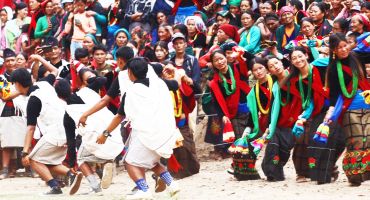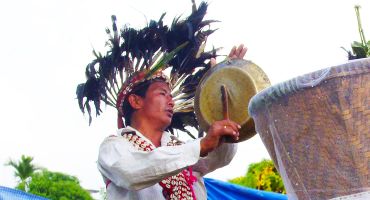The Kirat Mundhum religion has its own rules, laws, bylaws, code of conduct, and discipline. It is up to the Shamans (Mangpas) to facilitate them. A Mangpa is a medium between the physical and the divine.
- Mangdowa
- Nakchhong
- Saarimangpa
- Mangpa
- Bungwa Mangpa
a. Mangdowa/Woptongmi
Mangdowa performs worship rituals of one particular family lineage. Other than this, he helps pray for peace and harmony and strength from the ancestors. A Mangdowa has no teacher and are self learned.
b. Nakchhong
During the lack of a crop harvest, Nakchhongs perform worship rituals during Rawa Udhauli and Ubhauli. They are self-learned, self-realized and do not have a teacher. During the unavailability of Nakchhongs, others can be chosen to perform the ritual worship at the Sakenwa altar. They do not have to worship the Hutlung (Sanctum Stones) after that.
c. Saarimangpa
Saarimangpas heal people who are affected by ghosts, bad spirits, or witches. They perform rituals using rice grains (acheta) to pacify wandering body-snatching spirits. It is believed that Saarimangpas establish wandering spirits (borne of unnatural death) into the ancestral spirit world. They gain knowledge and wisdom from a guru. During rituals, they use Bouquet Grass (Amliso), Ginger (Aduwa), Persea dutbei (Kaulo), Poaceae (Ghungring), White Castanopsis (Kattus).
d. Rungpukmi/Rawenmi
The Mangpas who have no masters are always self-learned. Many Mangpas claim to be disciples of the Ban Jhankri (forest-dwelling Shaman). Such Mangpas are known as Raahangmi, Suksangmi Mangpas. Such Mangpas use flowers even more than the Saarimangpas during their rituals. They bring Mamaang (female evil spirits) and Halla (male wandering spirits) onto the right path and help the people affected by such spirits. Thereafter, the Kirat Mundhum believes that people are freed from the adverse effect of such spirits.
e.Bungwamangpa
There are flowers located at different body parts of the Kiratis and if these flowers are moved or withered, Bungwamanpas reestablish them. Since they are self-learned, they do not have a teacher. With the help of 362 different flowers, they travel the universe during their ritualistic process. They can change their appearances (Chusawa) and can also become invisible. These are powerful Shamans. They worship Budahang and also known as Bungpenmimangpa. Mundhum says that they possess tantric powers to kill their enemies.





Leave a Reply